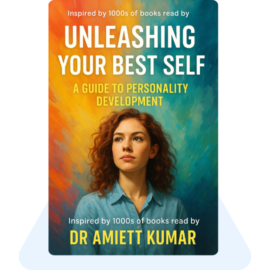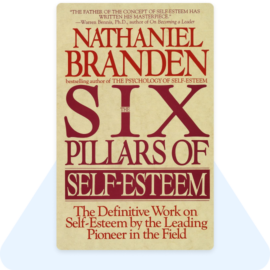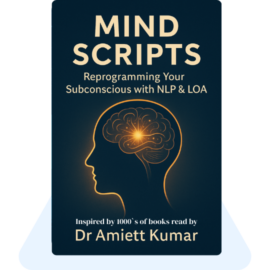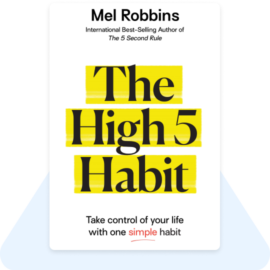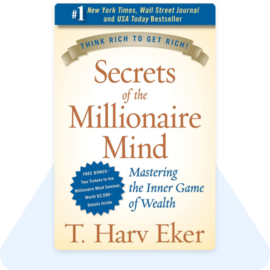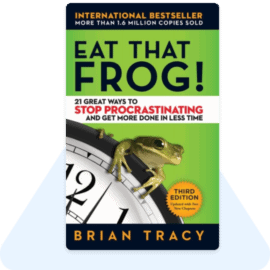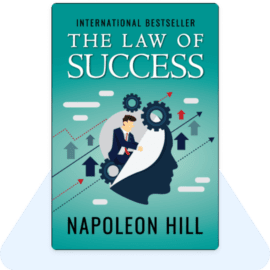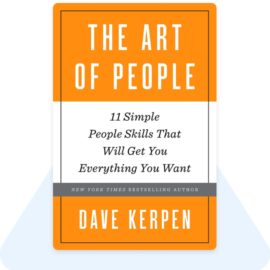Every person carries two versions of themselves — the one the world sees, and the one they truly are inside. Personality development isn’t about pretending to be someone else; it’s about aligning these two versions until they become one powerful, authentic, magnetic presence.
In a world driven by appearances and performance, personality is often mistaken for looks, dressing sense, or eloquence. But true personality runs deeper. It is the integration of your thoughts, emotions, energy, and actions. It is how you make people feel in your presence — and how you feel about yourself when you’re alone.
Dr Amiett explains that personality is not fixed; it is an evolving structure shaped by habits, beliefs, and emotional intelligence. Like clay, it can be molded — consciously and beautifully. The key lies in understanding the inner mechanisms that shape behavior and learning to refine them through awareness, mindset shifts, and practice.
This book explores personality not as a social performance but as an inner art — the art of becoming the most confident, calm, and connected version of yourself. Through psychology, NLP, and the spiritual science of energy, you will learn to develop a personality that radiates confidence, authenticity, and grace.
By the end, The Evolved You will not just change how others see you — it will transform how you see yourself.
Chapter 1 – Understanding Personality: Beyond Looks & Labels
What exactly is personality? Most people confuse it with surface-level traits — appearance, speech, or social charm. But personality is far more profound. It is the pattern of energy, emotion, and behavior that defines how you experience life and how life responds to you.
Dr Amiett explains that personality is the bridge between your inner world (thoughts, emotions, self-image) and your outer world (communication, decisions, relationships). When the bridge is strong and aligned, life flows effortlessly. When it’s weak or imbalanced, we experience confusion, anxiety, and social friction.
Modern psychology describes personality as a collection of consistent patterns — how you think, feel, and act across different situations. But in ancient spiritual understanding, personality is also seen as an aura — a field of vibration shaped by one’s mindset and emotional frequency. Together, these perspectives reveal that your personality is not static — it evolves with awareness.
“Personality begins where comparison ends. It’s about expressing, not impressing.” – Dr Amiett Kumar
To evolve personality, you must move beyond the superficial and start exploring:
- Your thoughts: What stories you tell yourself daily.
- Your emotions: What energy you radiate unconsciously.
- Your actions: How consistently you live your values.
When these three layers align, your personality becomes magnetic — not because you’re louder, but because you’re authentically grounded.
The first step in personality development is not learning social tricks, but self-awareness — noticing how you show up in different situations and why. Once you see the patterns, you gain the power to redesign them.
Key Takeaway
Observe yourself for a week. How do you behave with friends, family, or colleagues? Notice what changes and what stays constant. Awareness of your current personality is the first step to evolving it.
Chapter 2 – The Power of Self-Image
Every person lives according to an invisible blueprint — their self-image. It’s the mental picture you hold of who you are, what you can do, and what you deserve. Whether you realize it or not, this inner image dictates how you speak, behave, and even what kind of opportunities you attract.
Dr Amiett explains that you can never consistently perform in a way that’s different from how you see yourself. If you see yourself as shy, even training in communication won’t last; your subconscious will pull you back to that image. But when you begin to see yourself as confident, your behavior naturally aligns with that belief.
Psychologist Maxwell Maltz, in Psycho-Cybernetics, discovered this truth while performing surgeries — when a patient’s physical flaw was corrected, only some people’s confidence improved. Others still felt inferior. Why? Because their inner self-image didn’t change.
“You can’t outperform your self-image — but you can upgrade it.” – Dr Amiett Kumar
To transform your personality, start by reprogramming the subconscious image you hold of yourself:
- Identify Old Beliefs: “I’m not good enough,” “I can’t speak well,” “I’m not confident.”
- Visualize the New You: See yourself walking tall, smiling, speaking calmly.
- Affirm with Emotion: “I radiate confidence and authenticity.”
- Act as If: Behave like the person you’re becoming — not waiting to feel ready.
When practiced daily, this alignment of thought, feeling, and action rewires your self-concept. Your personality then shifts effortlessly, not through force but through identity evolution.
Key Takeaway
Rewrite your inner story. Every morning, repeat: “I am confident, expressive, and calm.” Visualize this version of you before starting your day. You’ll notice your outer personality begin to match your inner vision.
Chapter 3 – Mindset & Emotional Intelligence
Your mindset is the lens through which you interpret the world, and your emotional intelligence is the skill that determines how you respond to it. Together, they form the backbone of an evolved personality.
Dr Amiett describes two core types of mindset, based on Carol Dweck’s research:
- Fixed Mindset: Believes abilities are static (“I’m just not good at this.”).
- Growth Mindset: Believes abilities can be developed through effort and learning (“I can improve with practice.”).
People with a growth mindset exude optimism and resilience — traits that make their personality magnetic. They don’t fear failure; they see it as feedback.
But mindset alone isn’t enough — it must be balanced with emotional intelligence (EQ). EQ is the ability to understand, regulate, and express emotions in healthy ways. It allows you to stay calm under pressure, empathize with others, and handle criticism with grace.
The Four Dimensions of Emotional Intelligence:
- Self-Awareness – Understanding your emotions and triggers.
- Self-Regulation – Managing impulses and reactions mindfully.
- Empathy – Sensing and respecting others’ emotions.
- Social Skills – Communicating clearly and harmoniously.
“It’s not your IQ that makes you likable — it’s your EQ.” – Dr Amiett Kumar
When mindset and emotional intelligence merge, personality transforms. You stop reacting and start responding. You stop proving and start improving. People begin to sense calm strength in your presence — an aura that can’t be faked or forced.
The essence of this chapter: your mindset shapes your growth, and your emotional intelligence shapes your grace. Together, they build a personality that shines with maturity and power.
Key Takeaway
Pause before reacting today. When emotion rises, take one deep breath and ask: “What response reflects my highest self?” Emotional control is silent strength — and it’s magnetic.
Chapter 4 – Confidence: The Core of Charisma
Confidence is not the absence of fear — it’s the ability to act despite it.
It’s the foundation upon which every great personality stands. You can have knowledge, skill, and intention, but without confidence, none of it gets expressed.
Dr Amiett explains that confidence is a state, not a trait. It’s not something you’re born with — it’s something you generate. Confidence arises when your mind, body, and emotions are in alignment with belief and purpose.
The 3 Pillars of Confidence:
- Self-Trust – Believing you can handle whatever happens.
- Competence – Building skills through repetition and feedback.
- Presence – Staying grounded in the moment instead of worrying about judgment.
“Confidence is silent. Insecurity is loud.” – Unknown
From an NLP perspective, confidence can be anchored. Think of a time you felt powerful or successful. Relive it vividly — the sights, sounds, emotions — and link it to a physical cue (like touching your wrist or taking a deep breath). With practice, you can trigger that state anytime.
Charisma, on the other hand, is confidence radiating outward. People are drawn not to perfection but to authenticity. When you’re grounded, comfortable in your own skin, and genuinely interested in others, you naturally become magnetic.
The core insight of this chapter: Confidence is not about becoming fearless; it’s about building trust in your ability to rise above fear.
Key Takeaway
Before any important event (meeting, conversation, or speech), close your eyes, take a deep breath, and recall a moment of success. Feel that confidence surge through you — and carry it forward.
Chapter 5 – Communication Mastery
If confidence is the soul of personality, communication is its expression.
How you speak, listen, and connect determines how your personality is perceived.
Dr Amiett explains that communication is not just about speaking well — it’s about transmitting energy clearly. Every word carries emotion, and every emotion carries vibration. When your energy is aligned with authenticity, people don’t just hear you — they feel you.
The 4 Dimensions of Powerful Communication:
- Verbal Communication – What you say. Use clarity, simplicity, and positivity.
- Vocal Tone – How you say it. Calm, confident tone builds trust faster than loud words.
- Non-Verbal Cues – Body language, posture, eye contact, and gestures. Your body often speaks before your mouth does.
- Listening – The most underrated skill. People who truly listen radiate empathy and intelligence.
“The art of communication is the language of leadership.” – James Humes
NLP offers techniques like mirroring (subtly matching body language) and pacing and leading (aligning with someone’s emotional state, then guiding it upward). LOA complements this by teaching that the vibration you hold while speaking matters more than the words themselves.
Dr Amiett emphasizes that effective communicators don’t speak to impress — they speak to express, connect, and uplift. Every conversation becomes an opportunity to exchange energy, not just information.
The essence of this chapter: communication is not performance — it’s presence. When you speak with clarity, confidence, and compassion, your personality becomes unforgettable.
Key Takeaway
Before your next conversation, pause and set an intention: “May my words bring clarity and calm.” Speak slower, listen deeper, and watch how effortlessly your communication elevates your influence.
Chapter 6 – Emotional Stability & Self-Control
True strength isn’t about how loud you speak or how fast you react — it’s about how calmly you can hold your center when life challenges you.
Emotional stability is the silent foundation of a powerful personality.
Dr Amiett explains that emotional stability means being able to feel deeply without being ruled by emotions. It’s the art of responding, not reacting. Most people get caught in emotional storms because they confuse emotion with truth. But emotions are temporary signals — not instructions.
The 3 Steps to Emotional Mastery:
- Pause & Observe – When triggered, take a breath. Observe what you’re feeling without judgment.
- Name the Emotion – “I feel angry,” “I feel anxious,” “I feel hurt.” Naming separates you from it — you are not the emotion.
- Redirect Energy – Channel the emotion into a constructive response (walk, journal, breathe, or communicate mindfully).
“Between stimulus and response, there is a space. In that space lies our power and our freedom.” – Viktor Frankl
Emotional stability also builds trust and respect. People are naturally drawn to those who remain calm in chaos. It shows maturity and confidence.
From a spiritual lens, emotions are energy in motion (E-motion). The key is not to suppress them, but to allow them to move through you with awareness. Meditation, breathwork, and mindfulness are tools that purify emotional energy, restoring inner balance.
The core lesson of this chapter: Mastering emotions doesn’t mean avoiding them; it means allowing them to serve, not control, you.
Key Takeaway
When anger or anxiety rises, take 3 deep breaths before speaking or acting. This simple pause rewires your response and builds unshakable emotional strength.
Chapter 7 – Breaking Limiting Patterns
Every person carries invisible chains — patterns that repeat, often unconsciously. These are mental and emotional habits shaped by past experiences, fear, and self-doubt. Until they’re broken, they silently block growth.
Dr Amiett explains that limiting patterns operate like hidden codes in the subconscious:
- “I’m not good enough.”
- “I always fail.”
- “People don’t understand me.”
These scripts dictate behavior, emotions, and energy — attracting experiences that match their vibration. To evolve your personality, you must consciously break and rewrite them.
The 4-Step Formula to Break Limiting Patterns:
- Awareness – Recognize repetitive thoughts or situations that drain you.
- Acknowledge the Root – Ask: When did I first start believing this? Most patterns trace back to childhood or early failure.
- Reframe the Belief (NLP Technique) – Replace “I always fail” with “Every challenge teaches me resilience.”
- Reinforce with Action – Take one step that proves your new belief true. Action cements reprogramming.
“You do not become free by fighting the darkness; you become free by turning on the light.” – Dr Amiett Kumar
From an LOA perspective, when you break limiting patterns, your vibration instantly shifts. The universe mirrors your internal change with new opportunities and relationships.
The essence of this chapter: patterns are not prisons — they are programs. Once you see the code, you can rewrite it.
Key Takeaway
List one limiting belief about yourself. Write its opposite empowering version. For the next 21 days, repeat and act on it daily. Watch how your energy and confidence evolve.
Chapter 8 – Presence & Charisma
Charisma isn’t about being the loudest in the room — it’s about being the most present.
When you are fully in the moment, connected to your energy and to others, your presence becomes magnetic.
Dr Amiett explains that presence is not something you develop externally — it’s an energetic state that arises when your mind is calm and your attention is pure. Most people’s energy is scattered: half in the past, half in the future. A charismatic person’s energy is fully here, now.
The 3 Pillars of Presence:
- Grounded Mind – Calm your internal noise; listen deeply to others.
- Open Heart – Radiate warmth, empathy, and genuine curiosity.
- Aligned Body – Stand tall, breathe deeply, and move with purpose.
“Charisma is the transfer of energy — when you’re alive, others feel alive.” – Dr Amiett Kumar
Charisma also grows when you drop the need to impress. People sense authenticity more powerfully than perfection. Your energy communicates before your words do.
In fact, according to research in communication psychology, non-verbal cues make up more than 70% of first impressions — tone, posture, eye contact, and smile all matter more than content.
To build magnetic presence, practice mindfulness: whenever you meet someone, give them your full attention. Listen as if they’re the only person in the world. Your calm, attentive energy will speak louder than any words.
The essence of this chapter: presence is your natural charisma — once you stop trying to shine, you start glowing.
Key Takeaway
Next time you’re in a conversation, slow down. Breathe. Maintain gentle eye contact and listen completely. That simple act of full attention will make your presence unforgettable.
Chapter 9 – Social Intelligence
No matter how confident or knowledgeable you are, life ultimately moves through relationships. The ability to understand, connect, and communicate with others — social intelligence — is the crown jewel of personality.
Dr Amiett defines social intelligence as “the art of sensing people’s energy and responding with empathy and clarity.” It’s the emotional wisdom that lets you navigate human dynamics gracefully.
The 4 Elements of Social Intelligence:
- Empathy – Understanding emotions beneath words.
- Adaptability – Adjusting tone and style based on who you’re speaking to.
- Authenticity – Being genuine, not manipulative.
- Influence – Inspiring others without forcing your ideas.
“The most interesting person in the room is the one most interested in others.” – Dale Carnegie
Socially intelligent people make others feel seen, safe, and significant. They don’t dominate conversations — they facilitate connection. They read micro-expressions, sense unspoken tension, and use humor, respect, or calm energy to harmonize the space.
From an energetic perspective, social intelligence is about vibration matching — aligning your energy to the frequency of understanding and compassion. The Law of Attraction works powerfully in relationships: what you radiate emotionally, you attract socially.
Dr Amiett suggests practicing “energetic empathy” — before entering any interaction, take a deep breath and silently affirm: “May my energy uplift this space.” It subtly changes how people respond to you.
The essence of this chapter: social intelligence is not manipulation; it’s emotional harmony in motion.
Key Takeaway
In your next conversation, focus 80% on listening and 20% on speaking. Observe tone, body language, and emotion. Respond with empathy — and notice how easily connection flows.
Chapter 10 – The Energy Signature
Every person carries an energy signature — an invisible frequency that others can feel even before you speak. You’ve met people who instantly uplift a room, and others whose presence feels heavy or draining. That’s energy — and it’s the unspoken essence of personality.
Dr Amiett explains that personality is not only psychological or behavioral — it’s vibrational. Your thoughts generate emotions, your emotions emit frequencies, and those frequencies create your aura — the energetic field others subconsciously respond to.
“Your energy introduces you before you even speak.” – Anonymous
This energy signature is shaped by three forces:
- Thoughts – What you focus on most.
- Emotions – The feelings you cultivate daily.
- Alignment – The harmony between what you think, feel, and do.
When these three align, your energy becomes magnetic. You don’t need to “try” to attract opportunities or people — your vibration naturally pulls them in.
From the perspective of the Law of Attraction, you don’t attract what you want, you attract what you are.
Dr Amiett suggests simple ways to raise your energy signature:
- Begin the day with gratitude.
- Stay conscious of your inner dialogue.
- Let go of resentment through forgiveness.
- Practice stillness or meditation daily.
The essence of this chapter: your energy is your silent personality. When your inner world glows, the outer world responds.
Key Takeaway
Before starting your day, close your eyes and ask: “What energy do I choose to radiate today?” Feel it — peace, confidence, love — and carry it with you as your invisible signature.
Chapter 11 – Habits of Highly Evolved Personalities
An evolved personality is not the result of random inspiration — it’s the outcome of consistent daily habits.
Who you are becoming is shaped by what you repeatedly do, think, and feel.
Dr Amiett describes that evolved personalities share common habits — not because they imitate each other, but because growth naturally produces discipline, gratitude, and self-respect.
The Core Habits of Evolved Individuals:
- Morning Clarity – They begin the day with purpose.
Meditation, journaling, or silent reflection sets the tone for calm productivity. - Gratitude Practice – Instead of complaining, they appreciate. Gratitude raises their emotional baseline and attracts more good.
- Continuous Learning – They read, listen, and explore. Growth is their lifestyle, not an occasional task.
- Emotional Clean-Up – They don’t let anger or resentment linger. They process emotions instead of projecting them.
- Mindful Communication – They speak with intention and respect. Their words heal more than they hurt.
- Physical Energy Care – They treat the body as a temple — conscious eating, movement, and rest.
- Service & Contribution – They find joy in helping others rise. True confidence expresses itself through contribution.
“Discipline is the bridge between who you are and who you want to become.” – Jim Rohn
These habits gradually shape identity. Over time, the evolved person doesn’t “try” to be calm, confident, or kind — they simply are.
Their daily rituals become their natural vibration, and that vibration builds their destiny.
The essence of this chapter: you don’t create success — you create habits, and habits create success.
Key Takeaway
Choose one habit that aligns with your highest self — gratitude journaling, daily reading, or a morning meditation. Commit to it for 21 days and watch your personality evolve effortlessly.
Chapter 12 – Authenticity & Purpose
Authenticity is the soul of personality.
While charm may attract attention and confidence may command respect, authenticity creates connection.
It’s the quiet strength of being completely yourself in a world that constantly tries to make you someone else.
Dr Amiett explains that authenticity is not about revealing everything — it’s about aligning your thoughts, words, and actions so that they all speak the same truth.
Most people wear masks to fit in — one at work, another at home, another with friends. But the more masks we wear, the more disconnected we feel inside.
True confidence begins when you stop performing and start being.
“When you are real, you need no approval. The world begins to trust your presence.” – Dr Amiett Kumar
Purpose is the second half of authenticity.
A person living without purpose may look successful, but will always feel restless. Purpose gives direction to your personality — it focuses your energy and anchors your emotions.
The 3 Steps to Align with Purpose:
- Know What Moves You – Notice what activities make you feel alive.
- Connect It to Service – Ask, “How can my gifts help others?”
- Live It Daily – Make purpose a practice, not a paragraph on paper.
When your life aligns with authenticity and purpose, your personality becomes not just appealing — it becomes inspiring.
Key Takeaway
Write one line that defines your current purpose. Read it every morning before starting your day. It will keep your actions aligned with your true self.
Chapter 13 – Legacy: The Ripple of Your Personality
Your legacy is not what you leave behind after you’re gone — it’s what you leave behind in every moment you live.
Every interaction, every word, every act of kindness is a ripple in someone else’s story. That ripple is your real legacy.
Dr Amiett explains that personality development reaches its highest stage when it moves beyond self-growth into soul-growth. When you stop asking, “How can I succeed?” and start asking, “How can I serve?”, your presence begins to uplift everyone around you.
“Your legacy is not built by followers, but by the hearts you touch.” – Dr Amiett Kumar
Evolved personalities naturally become influencers — not because they chase influence, but because they embody authenticity, peace, and purpose. People are drawn to their vibration.
Your greatest contribution to the world is not your wealth or words — it is your energy, your example, and the way people feel in your presence.
The essence of this chapter: your personality is your legacy — build it with love, awareness, and integrity.
Key Takeaway
At the end of each day, reflect on one question: “Whose life did I touch positively today?” Small acts of grace build great legacies.
Conclusion
The Evolved You: Mastering the Art of Personality Development is not a book about changing who you are — it’s about remembering who you’ve always been beneath fear, doubt, and conditioning.
Through these chapters, we’ve learned that personality is not a mask; it’s a vibration. It’s built from self-awareness, self-image, emotional mastery, and authentic action.
We explored how confidence grows from self-trust, communication becomes connection, and energy shapes presence. We saw that true evolution lies in aligning your habits, mindset, and purpose until your life itself becomes a message of strength and peace.
Dr Amiett reminds us:
Personality is not built in a day — it’s built every day.
Every thought you nurture, every emotion you manage, every word you speak — they all sculpt the energy you radiate to the world.
The evolved you doesn’t seek validation; it radiates self-assurance.
The evolved you doesn’t chase influence; it naturally inspires.
And the evolved you doesn’t wear confidence — it becomes confidence.
Because in the end, your greatest achievement is not success — it’s evolution.
Learn More from Dr Amiett Kumar:
Contents

